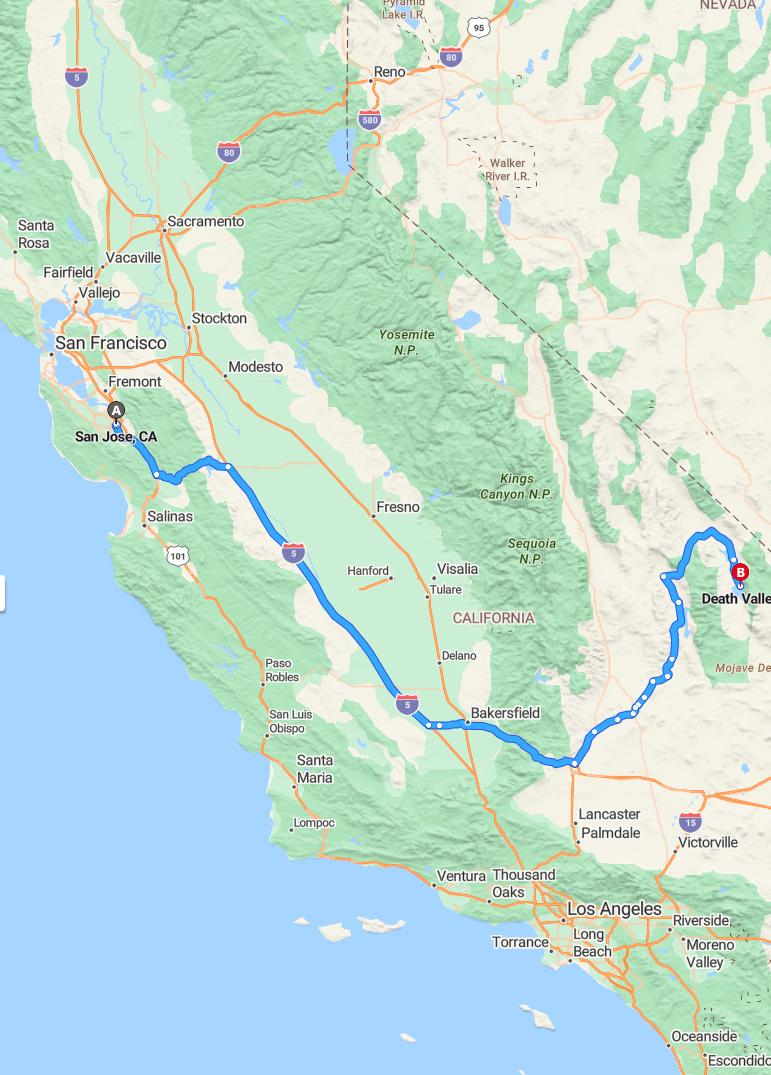Distance and estimated driving time
The journey from San Jose to Death Valley covers approximately 481 miles, taking an estimated 7 hours and 27 minutes by car. The route primarily follows I-5 S and CA-58 E, offering a scenic and efficient drive through California's diverse landscapes. Travelers should plan ahead for fuel, rest stops, and potential weather changes, especially as they approach desert areas. This drive provides an excellent opportunity to enjoy California's varying environments, from coastal regions to arid desert scenery.
Driving route
Traveling from San Jose to Death Valley involves an initial drive southward to Bakersfield, which serves as a key waypoint along the route. From Bakersfield, travelers head eastward into the vast and rugged landscape of Death Valley, renowned for its extreme heat and unique desert environment. The journey offers a diverse scenery, transitioning from the lush, urban areas of San Jose to the arid, expansive desert of Death Valley. This route provides an opportunity to experience California's varied ecosystems, from coastal to desert terrains. Proper preparation is essential, including adequate water, vehicle readiness, and awareness of weather conditions, especially when venturing into the harsh environment of Death Valley.

Best time to undertake the journey
The optimal time to undertake the drive from San Jose to Death Valley is during the cooler months of late fall through early spring, typically from November to March, to avoid extreme heat conditions. Traveling in this period ensures more comfortable driving and reduces the risk of heat-related vehicle issues in the desert. It is also advisable to plan the trip during daylight hours, especially when passing through Bakersfield and Death Valley, as temperatures can soar and visibility can be affected. Overall, visiting during this timeframe offers a safer and more enjoyable experience, allowing travelers to better appreciate the scenic journey and the unique desert landscape.
Road conditions and potential hazards
The drive from San Jose to Death Valley involves traveling through diverse terrains, with road conditions generally favorable on major highways. However, drivers should remain cautious of potential hazards such as sudden changes in weather, especially in desert areas where temperatures can fluctuate significantly. Construction zones and occasional debris may also pose risks along the route, requiring attentive driving. Additionally, long stretches of remote desert roads mean limited services and cell coverage, so travelers should be prepared with sufficient water, fuel, and emergency supplies.
Fuel stations along the route
Traveling from San Jose to Death Valley via Bakersfield offers several fuel station options along the route. In San Jose, numerous gas stations provide convenient refueling before departure, including major brands like Shell and Chevron. As you pass through Bakersfield, you will find a variety of fuel stations, ensuring a smooth continuation of your journey. Once in the vicinity of Death Valley, fuel options become more limited; therefore, it is advisable to refuel thoroughly in Bakersfield to avoid any inconvenience in the more remote areas of your trip.
Recommended stops and sightseeing spots
Traveling from San Jose to Death Valley via Bakersfield offers several notable stops and sightseeing opportunities. In Bakersfield, visitors can explore the historic Kern County Museum and enjoy local cuisine at renowned eateries. As you approach Death Valley, consider visiting the Brilliant Lava Pipe Trail or the Trona Pinnacles for unique geological formations and breathtaking landscapes. Once in Death Valley, highlights include Badwater Basin, the lowest point in North America, and Zabriskie Point, famous for its stunning sunrise views and colorful badlands.
Weather forecast and precautions
Traveling from San Jose to Death Valley, travelers should be prepared for diverse weather conditions. In San Jose and Bakersfield, mild temperatures and occasional rain are typical, so lightweight clothing and umbrellas are recommended. As you approach Death Valley, temperatures can soar well above 100degF, making hydration and sun protection essential for safety. It is advisable to carry ample water, wear protective clothing, and plan your stops carefully to avoid heat exhaustion or dehydration in the extreme desert environment.
Vehicle preparation and safety tips
Before embarking on a long journey from San Jose to Death Valley, ensure your vehicle is thoroughly prepared by checking tire pressure, fluid levels, and brake functionality. It's essential to carry emergency supplies such as water, a first aid kit, and a flashlight, especially when traveling through remote areas like Bakersfield and Death Valley. Ensure your vehicle's air conditioning system is working properly to cope with the extreme desert heat. Additionally, inform someone of your travel plans and estimated arrival time to enhance safety in case of unforeseen circumstances.
Alternatives and detours for scenic routes
Traveling from San Jose to Death Valley offers several alternative scenic routes and detours for travelers seeking a more picturesque experience. Instead of the straightforward drive through Bakersfield, you might consider taking the scenic route via Highway 58 through the Tehachapi Mountains, which provides stunning vistas and charming small towns. Another option is to detour through the historic Ridge Route, offering breathtaking views of the Sierra Nevada foothills. These alternatives enhance the journey by showcasing California's diverse landscapes, making the trip more memorable beyond the primary route.
Local regulations and driving tips
When driving from San Jose to Death Valley via Bakersfield, it's important to adhere to local traffic regulations, including speed limits and seasonal road closures. Ensure your vehicle is well-maintained, especially for extreme desert temperatures, and carry plenty of water and supplies. Be prepared for varying conditions, such as high speeds on open roads and the possibility of sudden weather changes in desert areas. Always check current road conditions and weather forecasts before your trip to ensure a safe and smooth journey.
